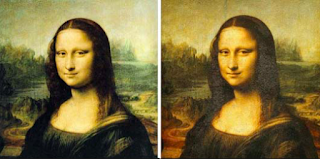Event 1- Eco-Centric Art + Science: Prophesies and Predictions
The event I went to was Puy on by Linda Weintraub. She was really passionate about having people use their bodies naturally, and experiencing natural sensations that we do not get to experience much of any more. She asked each of us how much walking we do on natural surfaces (hiking, sand, rocks etc.) Out of the 20 people at the event, only about 4 of them spent more than 5% of their time on natural surfaces. She then began to talk about how machines are making our lives easier, but people are not using their bodies full potential. Human bodies had to use to their maximum ability, and humans relied on all of their senses. In her exhibit, she tries to bring back the uses of human senses by using 5 different stations. At each station you took a box, and followed the instructions on the box. Below is a map of the different stations.
The picture below is a map of the exhibit.
The one in the top right side of the poster was form and beauty. At this station there were four different boxes, and within the boxes were different pieces of honeycomb. The point of this was the fact that bees live in hexagons, and humans live in squares. Both provide the same thing each species need, but they take different shape. Each species needs the same things (shelter, food, water) but the way they get these things do not need to be the same.
Going clockwise to the next portion of the exhibit is touch and texture. The box I chose at this station was about birds and their feather. Birds use their feathers for different things (flight, shelter, protection, warmth) and each feather has a different texture. The thick feathers were used for flight, the full feathers were used for warmth in the winter time. The super thin feathers were used for the summer time when they still needed protection, but did not need the warmth the thick feathers provided. There were also different feather from different types of birds. Each feather differed in length, texture, color and shape. This shows us that the human species is not the only species that looks different on the outside. Other species have difference just like humans do, and they use these differences for their specific needs.
The station in the bottom right hand side of the map was about volume and dimension. At this station I had to organize acorns in order from largest to smallest. The theme of this exercise was similar to the last one in the fact that each of these acorns had different sizes, yet they were all acorns.
Moving over to the left side of the map, the bottom station was about mass and weight. The box I interacted with just asked me to observe dirt, and how wood grows from it. The dirt trees grow from original has a heavier mass then the wood does, but over time the wood grows strong using the dirt, but the dirt never stops supporting the dirt and helping it grow. I am not entirely sure if Linda Weintraub intended for there to be so many hidden messages within these stations, but that is how it spoke to me. Humans use science and art to help them grow, and even though we might out grow and outsmart some technology and art, they will be apart of out society forever, and never help us stop growing as a species.
The station in the top left of the map was about flavor and aroma. This was my favorite station because I was able to taste maple syrup Linda made herself from sap. This just shows that nature can give us natural, delicious tasting things, and not everything needs to be processed from a machine like much of our food now a days is. Just another way our society relies on machines for everyday needs.
The last station, and the biggest one on the map, located in the middle of the room was Linda’s favorite. It was the idea she was most passionate about, using our bare feet to give us information about the ground beneath us. At this station we took our shoes off and walked around on different textured items found in nature, and recorded how it felt on our feet. Some were uncomfortable, some were soft, and some were familiar. This is what our bodies were designed to walk on, yet we have turned away from it. Linda encourages people to walk on “un-manmade surfaces” as often as they can, and try to take back what our bodies were made for.








Comments
Post a Comment